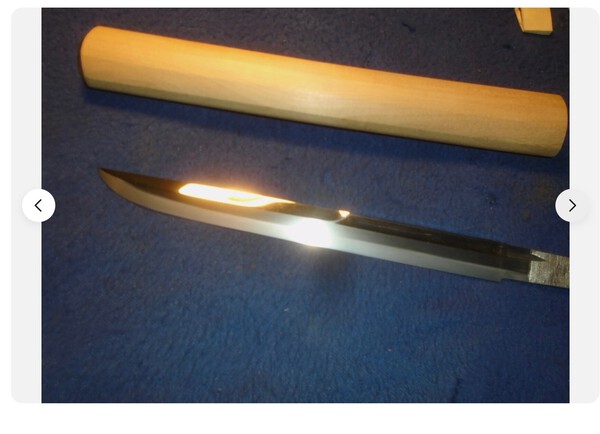-
Posts
383 -
Joined
-
Days Won
2
Hokke last won the day on October 12
Hokke had the most liked content!
Profile Information
-
Location:
Florida
Profile Fields
-
Name
Calabrese
Recent Profile Visitors
The recent visitors block is disabled and is not being shown to other users.
Hokke's Achievements
-
Excellent tutorial sir, thank you for taking the time and effort to post it.
-

Increasing Gold Membership numbers?
Hokke replied to Brian's topic in General Nihonto Related Discussion
I have given this some thought and I think I have to disagree, at least with regard to a fee for mei translation, which I regard as a potential primary revenue source for the forum. First, let's address the very basic types of nihonto owner/purchaser. First we have the one who found or was gifted granddad's sword, who is looking to sell it, period. No interest other than revenue. A fee for the identification of the mei is appropriate and would be nominal, say $5. They pay, they sell and then they never dip their toe in our pool again, easy peasy. They win and the forum wins by gaining operational revenue. If you believe providing this information for free will somehow "convert" someone into an enthusiast.......I dont see it. But if you add up all the accounts that have been created and only have one post or many posts but ONLY for mei identification and multiply that by a factor of five......... Then we have those like most here. They caught the bug for whatever reason and are actively looking to enter in to the world as a hobby. They come to the forum, ask questions and show an interest by attempting to contribute where possible. The more time they spend here the more information that are exposed to, accessing years and years of collected discussions.....for free, like a library, which is how I regard this place and why I have participated in heated discussions with those who sought to turn it into a ego club. The key here, as I see it, is how to determine when someone has participated enough to demonstrate a genuine interest this hobby. This would be a badge that would exempt them from the mei translation fee. The easiest way to achieve this as I see it, other than adding it to the perk list of a gold membership, is to use the system already in place. This forum uses the reputation system and new mods have recently been assigned to sections. While I may not agree with all mod actions, I have not seen any overstep or blatant bias. All mods that I have seen are long time contributors and relatively knowledgable. So, I would suggest that in addition to the emojis everyone has access to, that there be a specific emoji or other marker only available to mods and admin. This marker is only given to new members when they contribute productively in the eyes of the mods and admin. Perhaps all new members are given a "prospective member" status until they reach a predetermined marker number showing they have contributed enough to achieve "full member" status. The consequence of this status is the forum has now added a contributing member and that member is now exempt from the mei identification fee. With regards to the mei identification fee, the only hiccup I see is that a fee can only really be charged if the identification is absolute. This is regarding actual physical mei and of course has nothing to do with determination of gimei. If there is question as to accuracy based on the mei condition or picture quality, a full fee should not be imposed. Perhaps there should be a two tier translation fee. One price for a full translation and one price for a "probable" translation. -
This reminds me of a time when I went with a friend to look at a private used mercedes for sale. Everything on the outside looked perfect and the owner was quick to present the "clean carfax", which of course showed that everything was in order. I then asked the owner if he would allow us to drive it to the dealership for a pre-purchase inspection, his reply was, "for what? Here is the clean carfax." Begrudgingly, he agreed and when the inspection was completed, it was found to have unreported rear end damage and a few aftermarket parts, all of which were never mentioned. The point is that NBTHK papers, like a carfax, are not a conclusion, but a tool. They are more valuable for those less informed on specific schools and styles, but a tool nonetheless. If someone chooses to regard papers as a conclusion, that is certainly their prerogative, but the consequence is they may be paying quite a premium to a dealer who may have priced it with that type of customer in mind.
-
I dunno D, that’s a fine line, but you may be right. The judge may have seen indications of detail in the blade that were not pronounced in its current polish. His recommendation to have it repolished to bring out those details for certain would certainly make it more easily judged for tokuju. On the other hand, humans are humans and he may have just been trying to steer money toward a friend of his. As for preserving nihonto for the long term, yes, it’s a goal, but since these swords will never see use, if a new polish will better exemplify the work of a smith, it would presumably be the last time it was polished.
-
-
Is there anything with contrast editing that was done the picture? To me, it’s similar to Hankei in the O mokume, but that activity in the hamon seems quite different. There are places where the hamon would extend father into the ji, but wasn’t for sake of uniformity.
-
I seem to remember the same being mentioned in a documentary on Musashi. I believe it was mentioned he was also buried in the standing position. Who knows, legends and stories are vast with this one. As for his bokuto, there is one in a museum, but I believe it is labeled as a replica. Anyone with an oar length piece of wood could have claimed it was “the one”. Even if one does exist, can’t see anyway to definitively prove it.
-
I, like Adam would love to see that if you find the opportunity.
-
I agree, dont see how it could be anything else
-
Yes, thats very strange. I dont think it's upside down though. Something else going on in that pic. I dont see any way to have gotten the habaki that high up on the nakago if it were upside down.Whatever the reason, its strange it actually went to print like that.
-
You and I both......ah well, one day I'll get something right, then I'll know it's time to hang it up and retire on an upnote
-
-

What makes a sword a masterpiece?
Hokke replied to Hoshi's topic in General Nihonto Related Discussion
Thank you Piers, no need to make a special inquiry on my behalf, I was just thinking out loud. Does the potter you mentioned have a site of a place where he sells his works, I would be interested to see them.







